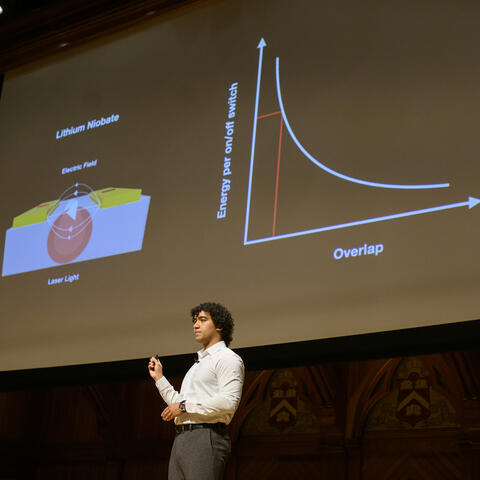Colloquy Podcast: The Geometry of Biology, Fashion, and Architecture

In their Harvard Horizons project, "Scissors Across Scales," physicist Noah Toyonaga explores the familiar mechanism of the “two-bar linkage” across different areas of knowledge and creativity—not actual scissors, but a geometric motif featuring two bars connected at a central pivot point that facilitates a shearing motion. Through study and imagination, Toyonaga takes a simple shape and envisions new applications in human immunology, the shelters we build, and even the clothes we wear.
This transcript was edited for clarity and correctness.
Hello. I'm Noah. And today, I'm going to be talking to you about geometry. Geometry for me is a way of seeing and a way of appreciating, understanding, and playing in the world. Let's begin. Geometry fundamentally is the study of shapes, so I'd like to begin with a basic but very important exercise. Let's think of some shapes. I'll start. A triangle. What are some other shapes?
Circle. Heart. Square. Beautiful. Ooh. Star. Spicy. I spent the last few years thinking about a very simple shape, one you're all familiar with, but perhaps still a little bit unexpected. And that's the geometry of a pair of scissors. Now, in my research, I'm interested in something a little bit more austere, so let's get rid of the sharp bit. Let's get rid of the handle.
And what we're left with, are simply two sticks with a pivot in between them which I'll call a scissor mechanism. Now, I've looked at this scissor mechanism in a variety of different contexts in biology, in textiles, and in architecture. Already, I think you can see something interesting, which is that these systems span over 10 orders of magnitude in size from the smallest to the biggest.
Let's begin with the smallest, biology. Now, this is a picture of a virus. I'm not a biologist, to be clear, but let me tell you what I know. A virus is an inert organic particle. It contains up in this bulbous head some infectious genetic material that it would like to put into a living cell in order to reproduce. But you promised scissors. Where are they?
Focus your attention on this stalk-like portion, what we call the tail. Now, if you squint your eyes, what you're able to see is that it's made up of a connected lattice of proteins that actually form a nanoscale lattice of scissors. Using this as a kinematic model, I was able to understand how the virus contracts and, therefore, how it infects its targets. Let's move on.
Textiles. This is a dress that was made about a century ago by a designer named Madeleine Vionnet. And it's important in the history of fashion, the history of Western haute couture, for being one of the first examples we have of a dress that is draped or cut on the bias. And if you don't know what that means, you're in for a treat.
So what I want you to note is the way that this fabric conforms to the body and wrinkles toward the ground even though it's made out of an inextensible inelastic material, silk. To say more, we need to talk about textiles, specifically, woven textiles. Now, if I take this handkerchief and I look closely at it, what I'll see is that it's actually made up of two independent sets of threads, a horizontal warp and a vertical weft.
Perhaps, you can already see where we're going. Again, we see this lattice of scissors emerging. What can we do with this? Well, let's do an experiment. I'm going to pull on this fabric parallel to the grain. Nothing much. But now let me pull what we call on the bias. Remember the dress. And suddenly, we see this miraculous elasticity and beautiful patterning of wrinkles emerging.
In my research, I've used the scissor model to understand this and other related textiles, which is important for the next generation of carbon fiber, active textiles, or perhaps, even as Madeleine Vionnet suggested, fashion. Now, let's proceed to architecture, but we're going to stop by art along the way. Many of you are probably familiar with a form of papercraft, which goes by the name of origami.
And here, what we do is start traditionally with a sheet of paper. I put some folds into it. And this allows me to make some interesting shapes. There's a related form of art, which is called kirigami. And here, what we do is I start with a flat sheet. I add some cuts in it. And again, this allows me to make some interesting forms. So let me summarize what I just said.
I start with a sheet. I add folds. Origami. I start with a sheet. I add cuts. Kirigami. Question. I start with a sheet. I had scissors. This is a form of art I call amigami. Let me show you a video. This is an amigami device that I've made. It consists of a lattice of scissors of various lengths. And it starts out in this collapsed form. But by deploying it, opening it up, you can see it changes from that flat form to a robust three-dimensional torus. Now, when I talk about this work, normally I have to say, imagine if that was really big. But today, I can just say, look at this.
[APPLAUSE]
So this remarkable object was made by the incredible folks at the BOK Center using this model that I designed. And well, first of all, just watch it jiggle. It's incredible. What is it good for? I will let you figure that out. I'm just calling it Big Donut. But seriously, I think that amigami, this form of using a lattice of scissors, is applicable to a host of problems in architecture and technology––from designing portable renewable energy installations to ultra-lightweight spacecraft.
And here in my research, I've designed algorithms that let me explore the full space of possible structures. So now let me go back to where we started. I talked to you about three different contexts. I talked to you about biology. I showed you a bunch of phenomena in textiles and introduced you to a new type of mechanical art and technology. In each of those spaces, we saw how the scissor mechanism appeared and allowed us to say something new and interesting.
I think it's pretty fantastic. But let me leave you with a secret. There's nothing magical about scissors. In fact, all of the shapes that we came up with earlier can be similarly unpacked to reveal a host of beautiful and unexpected phenomena. So as for your heart, your square, your circle––I'm forgetting a few. But for all of those, look around the world and imagine the possibilities.
Get the Latest Updates
Join Our Newsletter
Subscribe to Colloquy Podcast
Simplecast Stitcher





